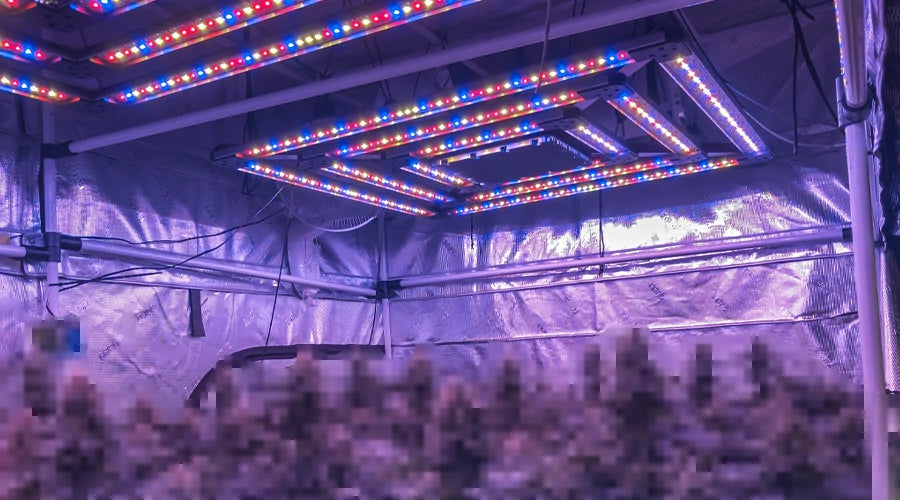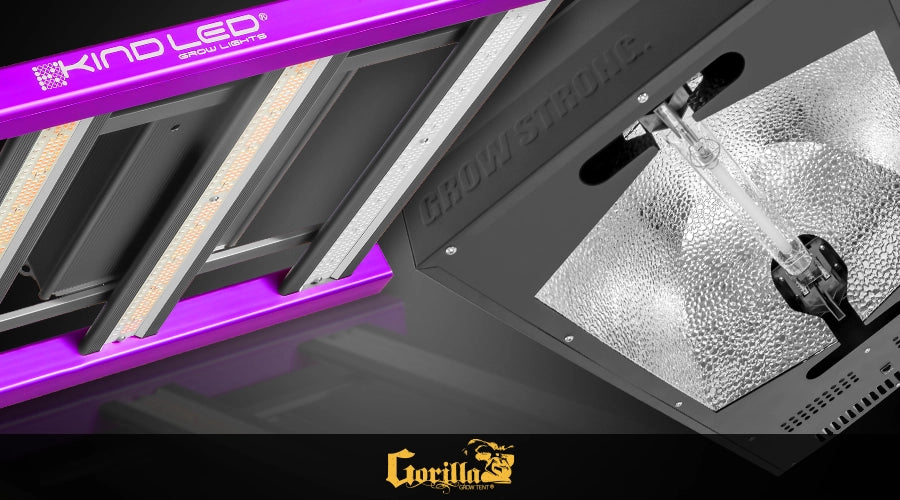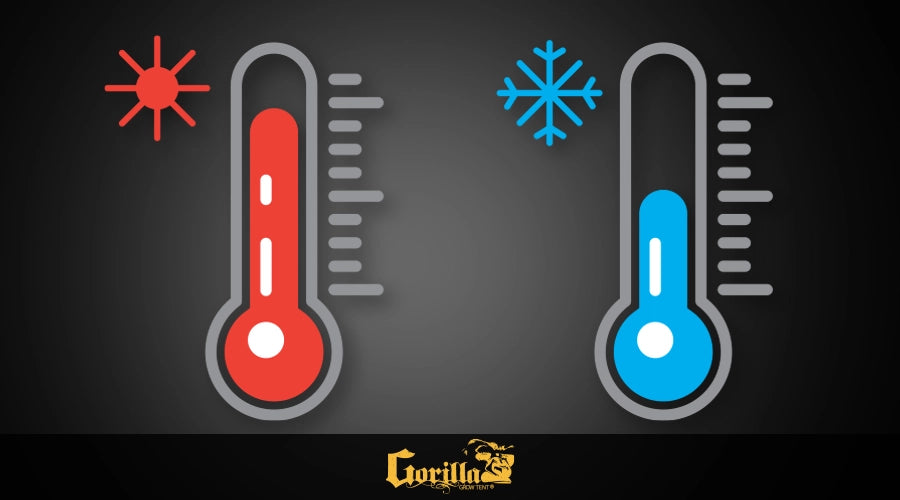
How to Install LED Grow Lights in Your Indoor Garden
We dedicate this article to providing information on how to install LED lights in your indoor garden.
You already know that by installing LED grow lights in your indoor garden, you will not be providing the light your plants need to grow and thrive. we tell you what you need to pay attention to how to do the great installation
we will tell.

A Beginner's Guide to Installing LED Grow Lights in Your Indoor Garden
Here are the steps to follow for a successful installation:
Determine the type and size of LED grow light you need based on the size of your indoor garden, the type of plants you are growing, and the growth stage they are in. Consider factors such as wattage, color spectrum, and coverage.
Choose a location for your LED grow light near your plants and easily accessible for maintenance. Make sure the area is well-ventilated and has enough room for light and necessary equipment.
Suspend the LED grow light using an adjustable rope or chain system. Make sure it is securely attached to the ceiling or support structure.

Connect the LED grow light to a power source using the included power cord. Follow the manufacturer's instructions carefully and avoid overloading the circuits.
Set the timer on your LED grow light to provide the appropriate amount of light for your plant's specific needs. For most plants, this will be 12-16 hours a day.
Monitor the light output of your LED grow light regularly and adjust the height and position as needed to avoid burning or stressing your plants.
Maximizing Plant Growth with LED Grow Lights in Your Indoor Garden
Basically, we can list the stages of installation like this. Now let's tell you some of the tricks of this business.
Choose the right color spectrum:
LED grow lights are available in a variety of color spectrums, from warm white to cool white, red and blue. Different plants have different needs at different stages of growth. For example, red light is best for flowering, while blue light is best for vegetative growth. It is important to choose the right color spectrum for the particular plants you are growing.
Determine the appropriate power:
The power of your LED grow light will depend on the size of your indoor garden and the type of plants you are growing. Watts will determine the intensity of light that can affect plant growth. Too much light can burn plants, too little light can cause them to yawn.
Consider using multiple lights:
If you have a large indoor garden, it can be beneficial to use multiple LED grow lights to provide more even coverage and ensure that all plants receive adequate light. This can also help prevent circuits from being overloaded and provide flexibility to adjust the position of the lights as needed.
Use a light meter:
A light meter can help you determine the intensity of light in your indoor garden and ensure your plants receive the appropriate amount of light. This can help you adjust the height and position of the lights and their on times.
LED Grow Lights for Seedlings: An Early Growth Guide
If you are planning to grow seedlings indoors and you have no knowledge about lighting, this article is for you. By using LED grow lights, you will be providing the right amount and spectrum of light to support the early growth of your seedlings.
From Seed to Sprout: A Comprehensive Guide to LED Grow Lights for Seedlings
Here are tips on how to use the right LED grow light for your seedlings:
Choose the right spectrum:
LED grow lights are available in different spectrums, including blue, red, and full spectrum. For seedlings, it is best to use a light with a higher percentage of blue light (about 400-500nm) as it promotes vegetative growth.
Position the lights correctly:
Seedlings require a lot of light, so make sure your lights are positioned close to them. Ideally, they should be no more than a few inches from the plants. As the seedlings grow, you can adjust the height of the lights accordingly.
Use a timer:
Seedlings need about 14-16 hours of light per day. Using a timer to turn the lights on and off will help ensure they get the right amount of light each day.
Watch the temperature:
LED grow lights can generate heat, so be sure to monitor the temperature in your grow area. Ideally, it should be between 65-75°F. If it gets too hot, consider using a fan or other cooling system to prevent damage to your seedlings.
Water your seedlings properly:
Seedlings grown under LED lights may require more water than those grown outdoors. Be sure to monitor the moisture level of the soil and water as needed.
Use the appropriate wattage:
The wattage of the LED grow light should match the number of seedlings you grow. As a general rule, you need about 25-30 watts of light per square meter of growing area.
Consider the size and type of your grow area:
The size and type of your grow area will also affect your choice of LED grow light. If you are growing seedlings in a small indoor space, a smaller LED light may be sufficient. If you are growing in a larger space, you may need a larger LED light or multiple lights.
Choose high-quality LED grow lights:
Not all LED grow lights are created equal. Look for high-quality lights with high PAR output (PAR stands for Photosynthetically Active Radiation, which is the amount of light plants can use for photosynthesis).
Consider the brand:
Choose a reputable brand that offers good customer service and warranties. This will ensure that you can get help if you have any problems with your LED grow lights.
Use the appropriate distance:
The distance between the seedlings and the LED grow light should be appropriate. Too much distance can cause insufficient light for the seedlings, and too little distance can cause heat stress or minor burns. As a general rule of thumb, keep the light 6-12 inches above the seedlings and adjust the distance as they grow.
Shedding Light on the Effectiveness of LED Grow Lights in Grow Tents
In recent years, LED grow lights have revolutionized indoor gardening, providing an energy-efficient and highly effective lighting solution. LED lights have become increasingly popular when it comes to growing plants in confined spaces like grow tents. In this article, we explore the effectiveness of LED grow lights in grow tents, shedding light on their benefits, considerations, and tips for maximizing their performance.
Illuminating Growth: Unveiling the Power of LED Grow Lights in Grow Tents
Understanding LED Grow Lights:
First, we delve into the basics of LED grow lights, discussing how they work and their advantages over traditional lighting options. From energy efficiency and longevity to customizable light spectrums, we highlight the features that make LED grow lights a compelling choice for indoor gardeners.
Tailoring Light Spectrum for Optimal Growth:
One of the significant advantages of LED grow lights is the ability to customize the light spectrum to meet the specific needs of plants at different growth stages. We explore the importance of various light wavelengths, such as red, blue, and white, in promoting photosynthesis, flowering, and overall plant development. Understanding these spectrums allows you to fine-tune your LED lights for maximum effectiveness.
Benefits of LED Grow Lights in Grow Tents:
This section delves into the specific benefits of using LED grow lights in grow tents. From their compact size and low heat emission to their targeted light distribution and reduced energy consumption, we outline how LED lights are well-suited for the confined space and controlled environment of grow tents. We also discuss their long lifespan and cost-effectiveness over the long term.
Optimizing Light Intensity and Distance:
Proper light intensity and distance play a crucial role in maximizing the effectiveness of LED grow lights. We provide guidelines on determining the ideal light intensity for different plant species and growth stages. Additionally, we discuss the importance of maintaining an appropriate distance between the lights and the plant canopy to prevent light burn or light deficiency.
Supplemental Lighting Considerations:
While LED grow lights can provide sufficient lighting for many plants, there may be instances where supplemental lighting is necessary. We explore scenarios where additional lighting, such as fluorescent or high-intensity discharge (HID) lights, can complement LED grow lights to meet specific plant requirements. Understanding when and how to incorporate supplemental lighting ensures comprehensive coverage for optimal growth.
Factors to Consider When Choosing LED Grow Lights:
Not all LED grow lights are created equal, and selecting the right one for your grow tent is essential. This section highlights key factors to consider, such as wattage, light output, coverage area, and brand reputation. We also touch upon features like dimmability, adjustable spectrums, and built-in cooling mechanisms, which can enhance the performance and versatility of LED grow lights.
Tips for Maximizing LED Grow Light Performance:
To get the most out of your LED grow lights, implementing certain practices can further enhance their effectiveness. We provide tips on proper light placement, light cycle management, and regular maintenance to ensure optimal performance and longevity of your LED grow lights. Additionally, we discuss the importance of periodic light spectrum adjustments based on plant growth stages.
Overcoming Common Challenges:
While LED grow lights offer numerous benefits, there may be some challenges that growers encounter. This section addresses common issues such as light intensity fluctuations, heat management, and potential light burn. We provide practical solutions and troubleshooting tips to help you overcome these challenges and maintain optimal performance from your LED grow lights.
Understanding PAR and PPFD:
To further understand the effectiveness of LED grow lights, it's important to grasp the concepts of Photosynthetically Active Radiation (PAR) and Photosynthetic Photon Flux Density (PPFD). We explain what these terms mean and how they relate to measuring the light output and intensity of LED grow lights. Understanding PAR and PPFD values can assist you in selecting the appropriate LED grow lights for your specific plant needs.
Case Studies and Success Stories:
Drawing inspiration from real-life experiences can provide valuable insights into the effectiveness of LED grow lights in grow tents. This section features case studies and success stories from experienced indoor gardeners who have achieved remarkable results using LED grow lights. Their stories serve as a source of inspiration and offer practical tips that you can apply to your own grow tent setup.
Environmental and Economic Benefits:
LED grow lights not only excel in plant growth but also offer environmental and economic advantages. This section explores their energy efficiency, reduced heat output, and long lifespan, which contribute to lower energy costs and environmental impact. We highlight how LED grow lights align with sustainable gardening practices and make them a smart investment in the long run.
Future Developments and Innovations:
As technology advances, the world of LED grow lights continues to evolve. This section provides a glimpse into the future of LED grow lights, discussing potential advancements and innovations that may further enhance their effectiveness in grow tent applications. Stay informed about the latest trends and developments to stay ahead in the world of indoor gardening.
LED grow lights have emerged as a game-changer in indoor gardening, especially in the confined space of grow tents. Their energy efficiency, customizable spectrums, and targeted light distribution make them highly effective for promoting plant growth. By understanding the benefits, optimizing light intensity and distance, considering supplemental lighting when needed, and selecting the right LED grow lights for your setup, you can harness their full potential. Shedding light on the effectiveness of LED grow lights in grow tents opens up a world of possibilities for cultivating thriving plants, no matter the season or available space.


